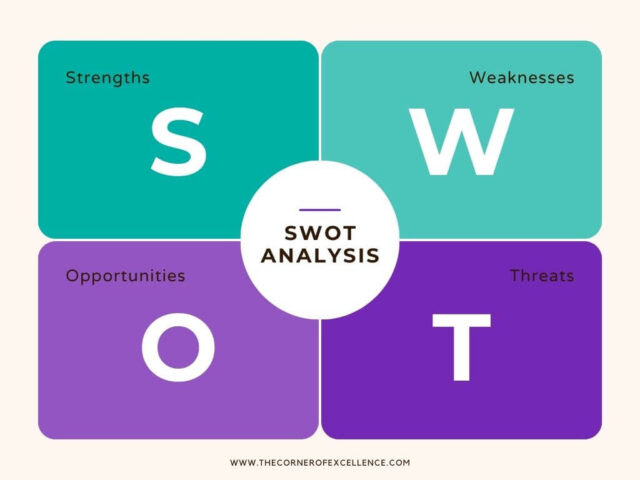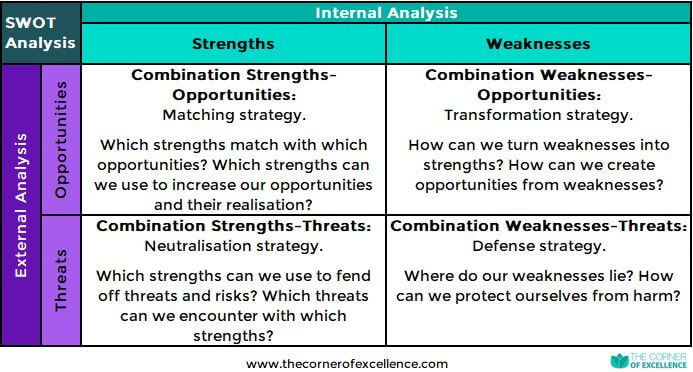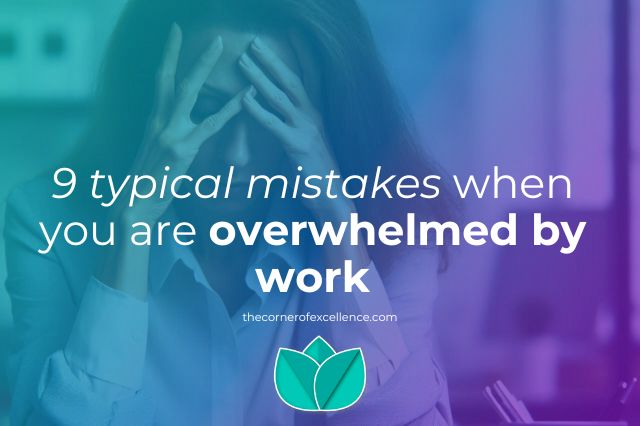In this post we will have a look into what a SWOT analysis is and why and how to do one to ourselves. I recommend this useful tool in the posts on stress due to a lack of support and feeling of insecurity. So let us see more in detail why.
What is the SWOT analysis
It is a tool in use since the 1960s in the world of business to study the situation of a company or project. The acronym means Strengths, Weaknesses, Opportunities and Threats. The analysis consists of the following four steps:
- Create the SWOT matrix
- Internal analysis (strengths and weaknesses)
- External analysis (opportunities and threats)
- Determine strategy to employ
Using this tool can be helpful for:
- Exploring new solutions to problems
- Identifying barriers which can limit objectives and goals
- Deciding on the most effective direction or orientation
- Discovering possibilities and limitations for change
- Review plan to better navigate organisations and systems
- Brainstorming
- Graphic representation in a presentation
Why use the SWOT analysis for ourselves?
As we have seen, this tool can help us detect barriers and limitations, find new solutions and decide the course to take. And these are aspects we may need at personal level at some point. Be it because we have lost our job and have a hard time finding a new one. Be it because we are dissatisfied with one we have but cannot come up with another job we could carry out. Or be it for improving our self-confidence. That is why I mentioned this technique in the posts Deal with stress due to a lack of support or recognition and Deal with stress due to a feeling of insecurity.
Sometimes we can feel stuck and do not see a solution or do not know what to decide. This is usually due to not being aware of all possible options or not believing that we have the resources to face the situation. In those times, reminding ourselves of our strengths and reflecting on all our opportunities might just be what we need. Also consciously admitting our weaknesses can be the first step to accepting them and working on some of them.
Even putting in black and white the threats we think we are facing could give us clues. That is, ideas of aspects to improve or threats that we could turn into opportunities if we change our focus or improve some knowledge, skill or aspect of ourselves.
How to carry out the SWOT analysis
1. Creating the SWOT matrix
Although you could start with the internal and external analysis, I suggest to first create the matrix. That is because our mind does not work in a linear way. Whilst you reflect upon your strengths you might come up with an opportunity. Or when musing about your threats you might think of a weakness. So I consider it a good idea to fill in the matrix little by little as the ideas come up.
The SWOT matrix looks like this:

2. Internal analysis
Secondly it is recommendable to do the internal analysis. That means thinking about and listing all our strengths and weaknesses.
On on hand think about knowledge and technical skills, that is things you are good at and things you are not that good at but deem necessary for your life or work. With this I mean to say it is not necessary to list everything you do not know or are not good at, thus growing your list of weaknesses with things that you do not need for your life. Why would I put on my list of weaknesses that I do not know about nuclear physics if I am neither a nuclear physicist nor aim at becoming one.
Also do not forget to list as strengths all studies, titles and courses you have done. If you have a title necessary for your work but think you remember little, this could be a point to add to your list of weaknesses.
On the other hand, reflect upon your social and soft skills: emotional intelligence, assertiveness, empathy, active listening, interpersonal, communication or leadership skills, proactivity, self-esteem etc. Which character and personality strengths do you have and which aspects do you think you could and should improve?
3. External analysis
After the look inside, the third step is to think about our environment. Which possible opportunities do you have? As regards to your job, could there be a vacancy at your company you are interested in? Have you seen announced a position where you could make use of knowledge or skills you do not put into practice right now? If you have a hard time finding a job in your profession, could there be opportunities in another field where your knowledge and skills fit?
Are there useful courses, workshops or seminars for your personal or professional development being offered in your community or on the internet?
What threats do you think you are facing? It could be for example working in a highly requested field and competing against very qualified people. Or it could be having a profession of less and less demand due to the economy’s evolution. Also we might be working at a company in difficulties and facing restructuring. Becoming aware of the possible threats will allow us to prepare for them and look for a way to face the situation.
Ask for help with your SWOT analysis
Both for the internal and the external analysis it can be helpful not to limit yourself to your own ideas. In order to really get to know ourselves and broaden the perspective, it can be a good idea to ask family, good friends, mentors, trustworthy people, colleagues and even bosses or ex bosses for their opinion. People from diverse areas of your life will know different sides of your way of being. So they may help you discover the impression you make on others.
Especially when we are feeling down and with low self-esteem, they will surely reveal us strengths we had not thought of. As well, with their knowledge and experiences they might discover us possible opportunities we had not come up with.
4. Determining the strategy
Once we have a complete vision we will be able to detect which strengths we could potentiate and which weaknesses we should work on. The list of threats can have made us aware of what we are facing in order to think about how to prepare ourselves for them. The list of opportunities can have revealed new paths to explore, be it on personal or professional level.
For that matter, it can be helpful to combine strengths and weaknesses respectively with opportunities and threats. With that we may pose questions like those you see in the matrix.

Conclusion
The SWOT analysis is a very useful tool to get to know ourselves better and analyse our situation and environment. Putting on paper our strengths, weaknesses, opportunities and threats can help us reveal strategies and goals for our personal and professional development.
Did you know the SWOT analysis? Have you ever used it? Do you think it can give you more clarity and focus for your life?
Sharing is caring!



